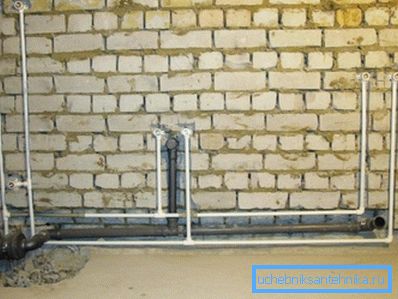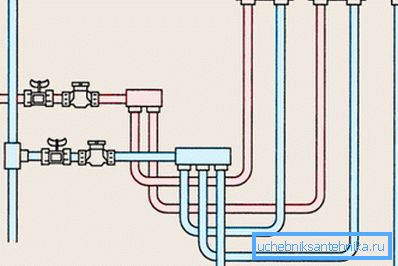Distribution of water pipes: schemes and materials used
What pipes should be used to dissolve water in a new apartment or cottage? How to connect plumbing fixtures? What is the difference between the serial and collector distribution of water pipes in an apartment?
Which one is more practical? Let's try to answer these questions.

Material selection
To begin with we will decide on the choice of pipes.
Please note: we’ll ignore the decision, which is usual for homes built in Soviet style, welded or assembled water pipes made of steel pipes. With a wealth of choices of modern materials, it’s simply impossible to come up with sound arguments in their favor.
What remains?
Scroll
- Metal-plastic. The reputation of these pipes is pretty spoiled by tales of current compression fittings; however, they didn’t deserve criticism: the only reason for the leakage was blunders during assembly, displacement of rubber seals due to the ovality of the pipe and the non-removed chamfer. In addition, press fittings for a good ten years of their operation were not noticed in the leaks.

- Polypropylene. Water distribution using polypropylene pipes requires certain skills; In addition, you need a specific tool - a low-temperature soldering iron.
For hot water it is better to use polypropylene, reinforced with fiber or aluminum foil: reinforcement dramatically reduces the elongation of the pipeline when heated. However, on long straight sections you still need to install compensators - U-shaped bends.
- Crosslinked polyethylene. Unlike conventional HDPE, it is much more heat-resistant and serves perfectly on hot water. Flexibility and simple installation on the fittings complete the picture.
- Corrugated Stainless Steel - Choosing a paranoid tenant. The ability to tolerate temperatures up to 130-140 degrees and pressures up to 25 atmospheres are combined with, again, flexibility and simple installation of compression fittings.

Costs
The price of pipes and fittings is one of the determining factors when choosing a material. How much will the buyer cost the linear meter of liner in each of the listed options?
| Material | Cost per meter, rubles |
| Polypropylene (reinforced), d = 20 mm | 120 |
| Crosslinked polyethylene, d = 16 mm | 80 |
| Metal, D = 16 mm | 70 |
| Corrugated stainless steel, D = 15 mm | 170 |
Please note: prices are highly dependent on the manufacturer of the product. In comparison, used products of brands of about the same level; You can always find significantly more expensive or cheaper deals.
It would seem, everything is clear: retail prices are distributed very clearly.
However, the cards will mix us up with additional costs.
- The cheapest fittings are polypropylene. With a small margin the second place is occupied by fittings for cross-linked polyethylene. Products for assembling metal-reinforced plastic and corrugated stainless steel are much more expensive.
- Metal-plastic is mounted on compression fittings using two adjustable wrenches; they will also help build a stainless steel construction. For polypropylene, a soldering iron with a cost from 600 to 1,500 rubles is needed, for cross-linked polyethylene - an extender for 8-12 thousand.

The author at the present time would probably dwell on metal plastics - simply because he has studied all the features of this material well. However, it is quite possible that the reader will make their own table of ranks.
Scheme
Let us return, however, to the wiring diagrams. What options are possible?
Sequential
You can see it, looking into the bathroom of any house of Soviet construction. All plumbing fixtures are connected to a common pair of pipes - cold-water and hot-water supply, branching made with tees.
The advantages of this scheme are simplicity and low cost. Does it have flaws?
The main problem of serial connection is the drop in pressure on one plumbing fixture when water flows through another. Loud and offensive words from the shower to the person who turned on the water in the kitchen are characteristic of a sequential scheme.

Collector
In this case, a collector is supplied from the riser or inlet, equipped with shut-off valves for each device. The liner of all the faucets, showers and toilets is also individual. If the cross section of the pipe to the collector is higher than that of the sanitary equipment, you can forget about the pressure drop.
What's the catch? In a large flow of pipes and the fact that these pipes in no way decorate the walls.
By the way: if the wiring of sewage pipes and plumbing is carried out before the finishing of a new house or apartment, they can be removed for false walls.

Mixed
Both schemes can be combined within the same bathroom. A typical example is when a washbasin, a kitchen sink and a shower cubicle are connected via a collector, and a washing machine and toilet bowl are connected through tees.
Which scheme is better to choose when installing a water pipe with your own hands?
- If in a city apartment all plumbing fixtures are located on the same line on one side of the riser, our choice is consistent wiring. The drop in pressure when using the described materials will be minimized by their low hydraulic resistance.
- In homes where the risers are located between the bathroom and toilet or bathroom and kitchen, it is preferable to have a collector. The number of pipes will not change, but the concentration of valves at one point will be very convenient.

- The instruction for the cottage is again determined by its layout. In general, the collector is justified where often the simultaneous use of several points of water flow.
Conclusion
We hope that the information offered to the reader will help him make the right choice. The video in this article contains additional materials on how the distribution of water supply pipes can be implemented (see also the article The distribution of pipes in the bathroom: how to do this).
Successes!